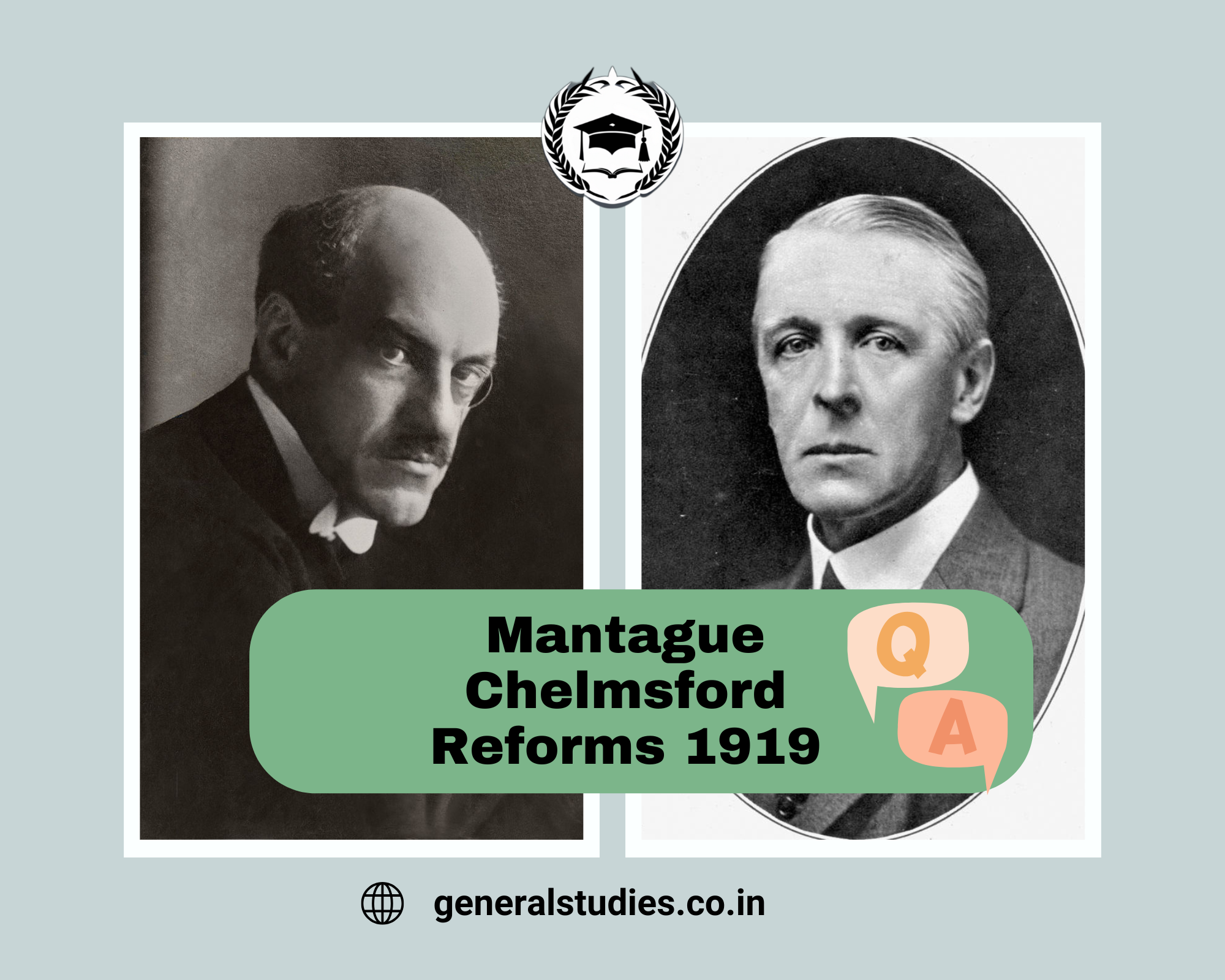Table of Contents

Introduction: Montagu Chelmsford Reforms 1919
The Montagu Chelmsford Reforms 1919, also known as the Government of India Act 1919, were a significant constitutional reform introduced by the British colonial government in India. The reforms were named after the then-Secretary of State for India, Edwin Montagu, and the Viceroy of India, Lord Chelmsford.
Objective: Montagu Chelmsford Reforms
- Increased Indian Participation: The reforms aimed to increase Indian participation in the governance of their country by expanding the role of Indians in legislative councils and government.
- Progress Towards Self-Government: While not advocating for immediate self-rule, the reforms were seen as a step towards eventual self-government for India within the British Empire.


Background
- Post-World War I Situation: The reforms were introduced in the aftermath of World War I, during which India’s contribution to the British war effort was substantial. Indian nationalists expected political concessions in return for their support.
- The Government of India Act 1909: Before the Montagu-Chelmsford Reforms, the British had enacted the Government of India Act 1909, also known as the Morley-Minto Reforms, which introduced limited electoral reforms.
Key Features of Montague Chelmsford Reforms
- In 1918, Secretary of State for India Edwin Montague and Viceroy Lord Chelmsford drafted a constitutional reform bill.
- Based on this, the Government of India Act of 1919 was enacted.
- The new Act increased the number of members of the Provincial Legislatures. The number of elected members was also increased.
- This new provision gave more power to the provincial governments.
- In this new act, a Dual Government System or “dyarchy” was followed.
- It was called “dyarchy” or “dual rule” because, in this system, the provincial government’s finances and law and order were included in the reserved list. The authority of these two departments was vested in the provincial governor.
- Departments like Education, Health, Local Self-Government, etc. were included in the “transferred list”. Arrangements were made to give the responsibility of these to the Minister or Ministers. These ministers were to be accountable for their actions to the governing councils.
- The finance department was responsible for arranging the funds required to carry out the activities of the departments mentioned in the transferred list (i.e. health, education, etc.).
- This finance department was, however, placed directly under the control of the Governor or Provincial Governor.
- Provision was also made that the Governor could overturn any decision taken by the Ministers for any special reason.
- There were two legislative or executive councils in the central government.
- Central Legislative Assembly: This assembly had 145 members, of which 41 were nominated by the government.
- Council of State (Upper House): The upper house had 60 members, out of which 34 were elected, and the remaining 26 were nominated by the government.
- The Legislative Assembly had no members from the princely states, as they were not part of British India.
- This executive council or council was not given any authority over the Governor General or his Governing Council, i.e. there was no mechanism to hold the Governor General accountable for his actions to the Central Executive Council or the National Council. Besides, the central government’s free right to exercise authority over the provincial governments was secured.
- Voting rights were restricted to a very small number of people for the election of members of the assembly or council.
- In 1930 the number of voters in the Legislative Assembly was 909,874.
- The number of voters in the Council of State was only 17,364.
- India’s nationalists no longer wanted to accept a foreign government promising to judge whether an Indian was fit to be independent.
- A special session of the Indian National Congress was held in Bombay in August 1918 under the presidency of Hasan Imam. The session was called to discuss reforming the Montague Chelmsford report. In this session, the demand for autonomy was raised.
Reaction of Montagu Chelmsford Reforms
- The Montagu-Chelmsford Reforms of 1919 had significant reactions and impacts on Indian society and politics.
- The reaction to the reforms was mixed among Indian nationalists.
Indian National Congress (INC)
- The Indian National Congress, which had been demanding greater autonomy and self-rule, was disappointed by the reforms. The National Congress strongly opposed them.
- Mahatma Gandhi was cautiously optimistic and saw the reforms as a first step towards greater self-governance.
- Some senior public leaders like Surendranath Bandopadhyay were in favor of accepting the Montagu-Chelmsford reform proposal.
- Due to these differences, Surendranath Bandopadhyay and his like-minded leaders severed ties with the Indian National Congress.
- They formed a political organization called “Indian Liberal Federation“.
- Later, such political leaders came to be known as liberals and their role in Indian politics became secondary.
Muslim League
- The Muslim League initially welcomed the reforms as they provided for separate electorates, safeguarding Muslim interests.
Montagu Chelmsford Reforms 1919 UPSC PSC MCQs
Will be uploaded soon.

